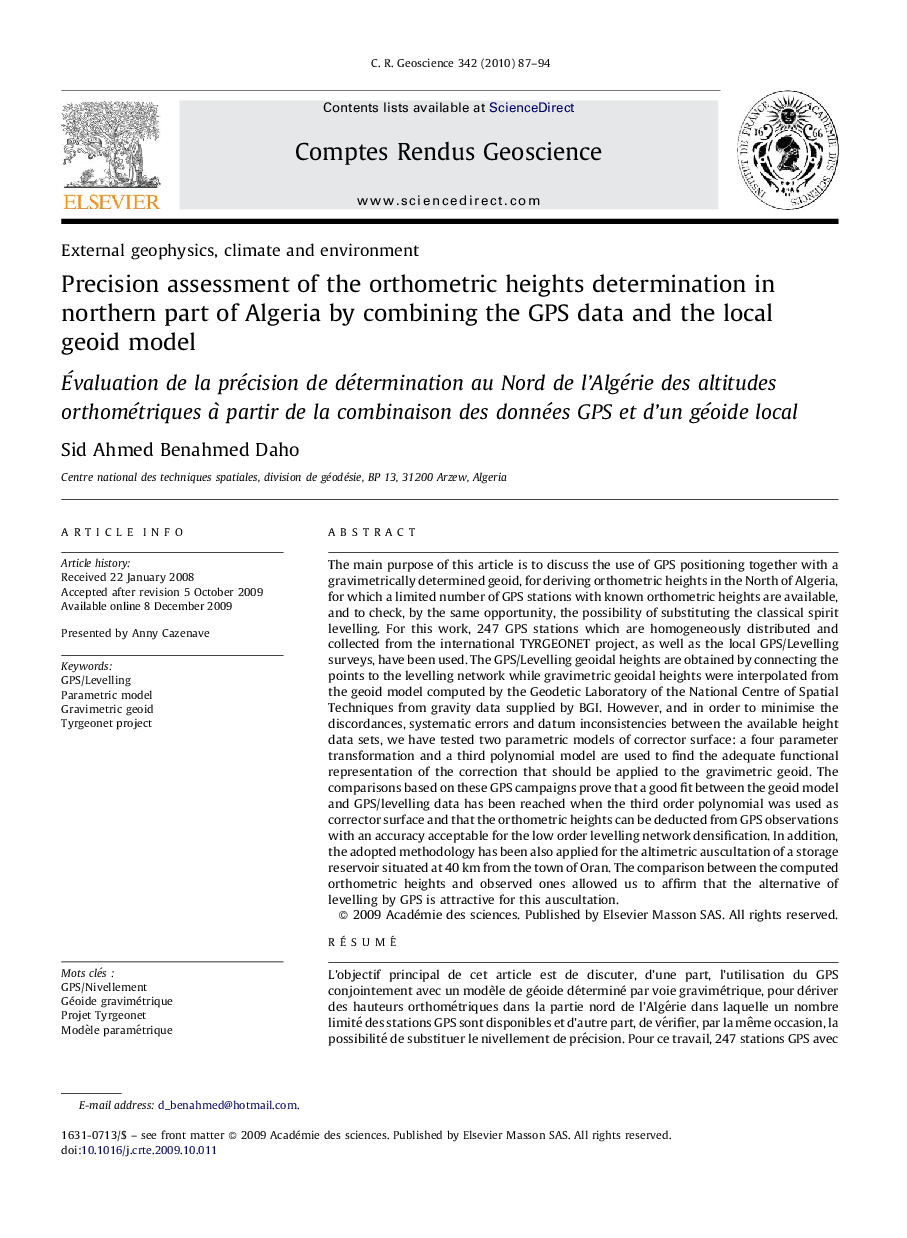| کد مقاله | کد نشریه | سال انتشار | مقاله انگلیسی | نسخه تمام متن |
|---|---|---|---|---|
| 4462504 | 1313504 | 2010 | 8 صفحه PDF | دانلود رایگان |

The main purpose of this article is to discuss the use of GPS positioning together with a gravimetrically determined geoid, for deriving orthometric heights in the North of Algeria, for which a limited number of GPS stations with known orthometric heights are available, and to check, by the same opportunity, the possibility of substituting the classical spirit levelling. For this work, 247 GPS stations which are homogeneously distributed and collected from the international TYRGEONET project, as well as the local GPS/Levelling surveys, have been used. The GPS/Levelling geoidal heights are obtained by connecting the points to the levelling network while gravimetric geoidal heights were interpolated from the geoid model computed by the Geodetic Laboratory of the National Centre of Spatial Techniques from gravity data supplied by BGI. However, and in order to minimise the discordances, systematic errors and datum inconsistencies between the available height data sets, we have tested two parametric models of corrector surface: a four parameter transformation and a third polynomial model are used to find the adequate functional representation of the correction that should be applied to the gravimetric geoid. The comparisons based on these GPS campaigns prove that a good fit between the geoid model and GPS/levelling data has been reached when the third order polynomial was used as corrector surface and that the orthometric heights can be deducted from GPS observations with an accuracy acceptable for the low order levelling network densification. In addition, the adopted methodology has been also applied for the altimetric auscultation of a storage reservoir situated at 40 km from the town of Oran. The comparison between the computed orthometric heights and observed ones allowed us to affirm that the alternative of levelling by GPS is attractive for this auscultation.
RésuméL’objectif principal de cet article est de discuter, d’une part, l’utilisation du GPS conjointement avec un modèle de géoide déterminé par voie gravimétrique, pour dériver des hauteurs orthométriques dans la partie nord de l’Algérie dans laquelle un nombre limité des stations GPS sont disponibles et d’autre part, de vérifier, par la même occasion, la possibilité de substituer le nivellement de précision. Pour ce travail, 247 stations GPS avec une distribution assez homogène, collectées à partir du projet TYRhenian GEOdynamical NETwork (TyrGeoNet) et quelques réseaux locaux ont été utilisés. Les ondulations du géoide issues du GPS/Nivellement sont obtenues en connectant ces stations au réseau de nivellement, tandis que celles du géoide gravimétrique ont été interpolées à partir du modèle de géoide calculé par la division de géodésie du Centre national de techniques spatiales, sur la base des données de gravité fournies par Bureau Gravimétrique International (BGI). Cependant, et afin de réduire les discordances et les erreurs systématiques et les inconsistances des datums inhérents aux différents types d’altitudes, nous avons testé deux modèles de la surface de correction: Similitude spatiale à quatre paramètres et un polynôme de troisième degré et cela, afin de déterminer le modèle approprié capable de représenter d’une façon optimale la correction totale qui devrait être appliquée au géoide gravimétrique. Les comparaisons basées sur ces campagnes GPS démontrent que ce modèle de géoide gravimétrique ajuste d’une façon optimale les données GPS/Nivellement quand le modèle polynomial de troisième degré est utilisé comme surface de correction et que les hauteurs orthométriques peuvent être déduites d’observations GPS avec une précision acceptable qui pourra être utilisée dans la densification des réseaux du nivellement d’ordres inférieurs. En addition, la méthodologie adoptée a été appliquée, également, pour l’auscultation altimétrique d’un bac de stockage situé à 40 km d’Oran. La comparaison entre les hauteurs orthométriques calculées et observées a permis d’affirmer que l’alternative de nivellement par le GPS est souhaitable pour ce type d’auscultation.
Journal: Comptes Rendus Geoscience - Volume 342, Issue 2, February 2010, Pages 87–94